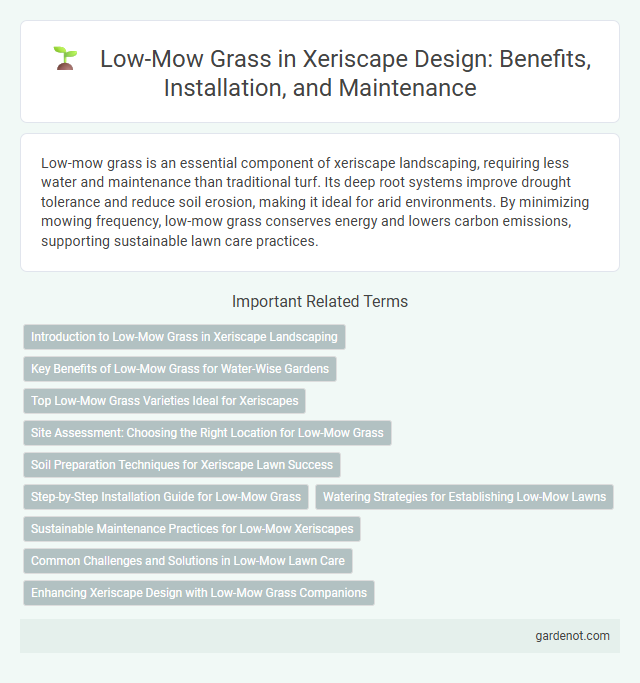Low-mow grass is an essential component of xeriscape landscaping, requiring less water and maintenance than traditional turf. Its deep root systems improve drought tolerance and reduce soil erosion, making it ideal for arid environments. By minimizing mowing frequency, low-mow grass conserves energy and lowers carbon emissions, supporting sustainable lawn care practices.
Introduction to Low-Mow Grass in Xeriscape Landscaping
Low-mow grass varieties like buffalo grass and fine fescues are essential elements in xeriscape landscaping for their drought tolerance and reduced maintenance needs. These grasses require less frequent mowing, conserving water and minimizing labor in arid environments. Incorporating low-mow grass supports sustainable landscape design by promoting water efficiency and enhancing soil health.
Key Benefits of Low-Mow Grass for Water-Wise Gardens
Low-mow grass reduces water consumption by minimizing evapotranspiration, making it ideal for xeriscape landscapes focused on water efficiency. Its deeper root system enhances drought tolerance and soil stability, promoting healthier, more resilient lawns. Maintenance costs decrease due to less frequent mowing and reduced need for irrigation, supporting sustainable garden management.
Top Low-Mow Grass Varieties Ideal for Xeriscapes
Top low-mow grass varieties ideal for xeriscapes include Buffalo Grass, known for its drought tolerance and minimal maintenance requirements. Fine Fescue blends thrive with reduced watering and mowing frequency, making them perfect for water-efficient landscapes. These grasses enhance xeriscape designs by conserving water while maintaining aesthetic appeal and ground cover.
Site Assessment: Choosing the Right Location for Low-Mow Grass
Site assessment for low-mow grass involves evaluating soil type, sunlight exposure, and drainage to ensure optimal growth and water efficiency. Selecting well-drained areas with full to partial sun supports deep root development, reducing irrigation needs. Proper site evaluation minimizes maintenance efforts, enhances durability, and aligns with xeriscape goals of sustainable landscaping.
Soil Preparation Techniques for Xeriscape Lawn Success
Soil preparation for xeriscape lawns with low-mow grass involves enhancing soil structure and drainage through the addition of organic matter and sand. Proper aeration and amending compacted soil optimize root penetration and moisture retention, crucial for drought-resistant turf health. Incorporating slow-release fertilizers tailored for low-water landscapes supports sustained growth and minimizes nutrient runoff.
Step-by-Step Installation Guide for Low-Mow Grass
Prepare the soil by removing existing turf and debris, then till and level the area for optimal root growth. Choose drought-tolerant, low-mow grass varieties such as Buffalo grass or Fine Fescues, and evenly distribute seeds or install sod following recommended spacing guidelines. Water thoroughly after installation and establish a low-frequency mowing schedule to maintain turf health while conserving water.
Watering Strategies for Establishing Low-Mow Lawns
Low-mow grass varieties require significantly less water, making them ideal for xeriscape landscapes focused on water conservation. Establishing low-mow lawns involves deep, infrequent watering to encourage drought-resistant root development, typically applying 1 inch of water every 7 to 10 days depending on soil type and climate. Mulching around grass roots helps retain moisture and reduces evaporation, further enhancing water efficiency in low-mow lawn care.
Sustainable Maintenance Practices for Low-Mow Xeriscapes
Low-mow grass varieties significantly reduce water usage and maintenance requirements in xeriscape landscapes, promoting sustainable gardening practices. These grasses require minimal mowing frequency and adapt well to drought-prone environments, enhancing soil health and biodiversity. Integrating low-mow grass with efficient irrigation and organic mulching further optimizes water conservation and reduces carbon emissions associated with lawn equipment.
Common Challenges and Solutions in Low-Mow Lawn Care
Low-mow grass in xeriscape design often faces challenges such as uneven growth, weed invasion, and pest susceptibility due to its reduced height maintenance. Solutions include selecting drought-tolerant, native grass species like buffalo grass or blue grama, implementing precise irrigation techniques to avoid overwatering, and regular dethatching to improve soil aeration. Integrating organic mulches and targeted herbicide applications further promotes healthy growth while minimizing maintenance requirements.
Enhancing Xeriscape Design with Low-Mow Grass Companions
Low-mow grass varieties like buffalo grass and blue grama enrich Xeriscape designs by reducing water consumption and maintenance needs. These drought-tolerant grasses create a lush, green carpet that complements native xeric plants while preventing soil erosion. Incorporating low-mow grasses enhances the sustainability and visual appeal of Xeriscape landscapes, promoting ecological balance in arid environments.
Low-mow grass Infographic

 gardenot.com
gardenot.com